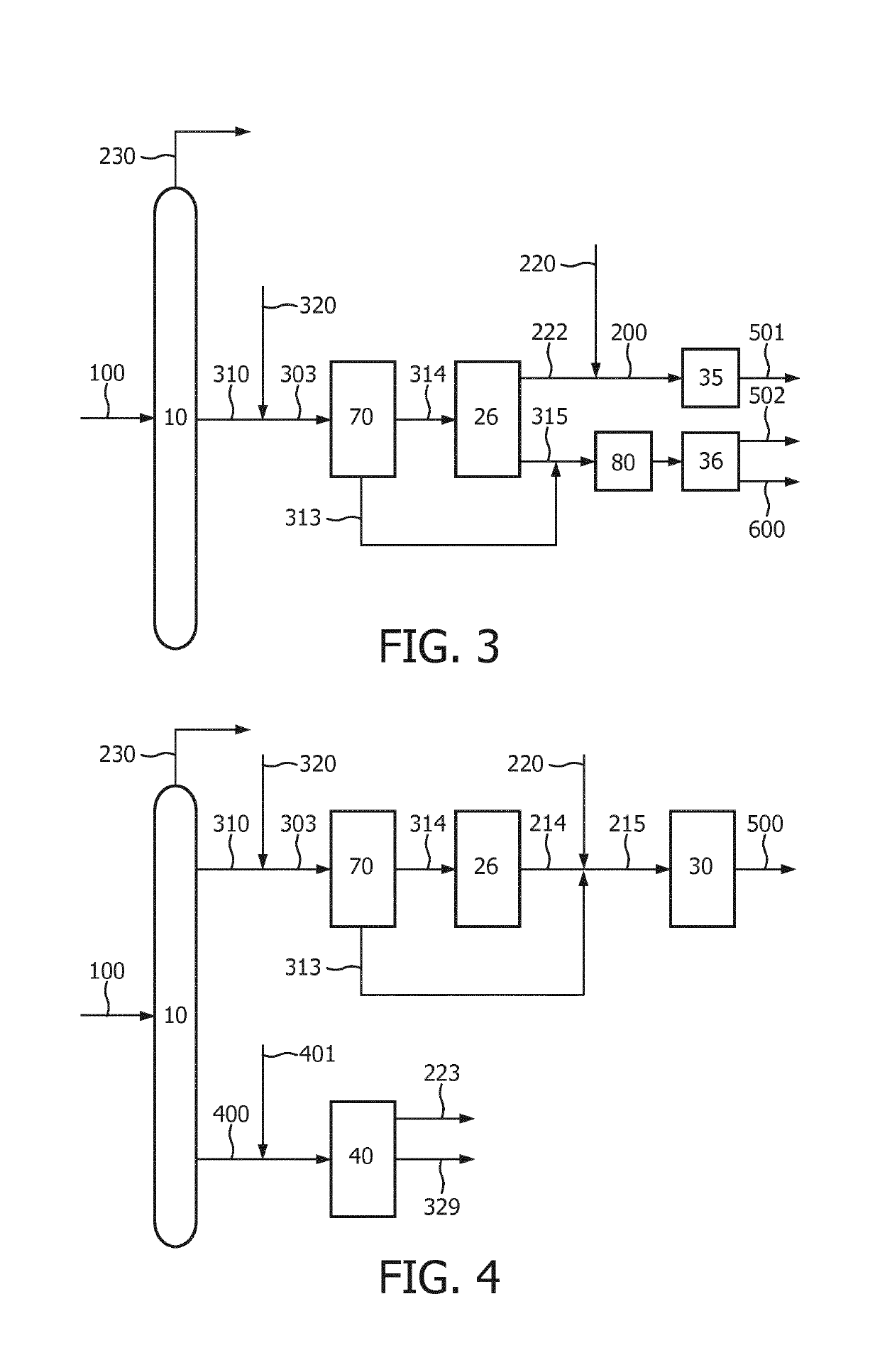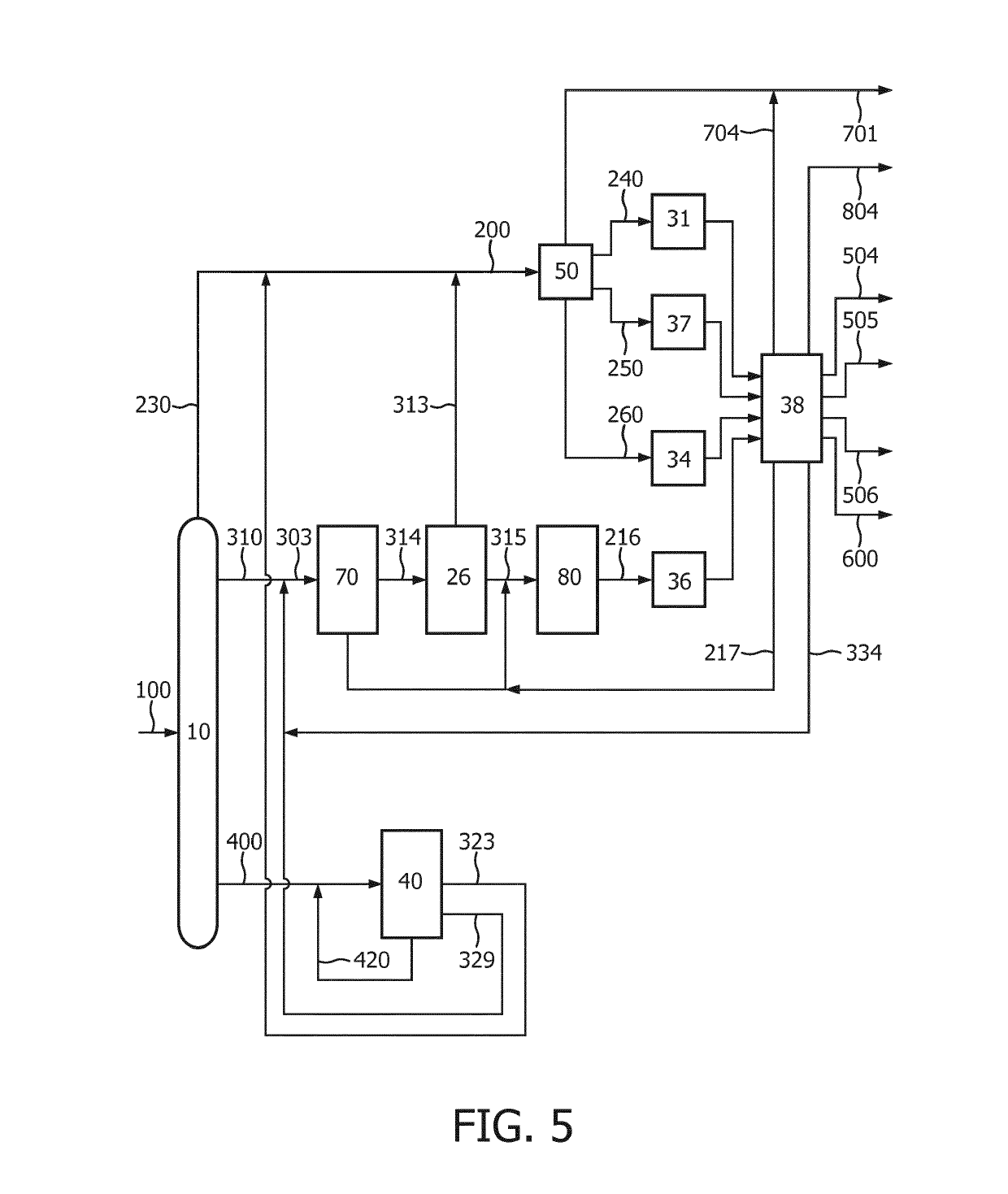Process and installation for the conversion of crude oil to petrochemicals having an improved ethylene yield
- Summary
- Abstract
- Description
- Claims
- Application Information
AI Technical Summary
Benefits of technology
Problems solved by technology
Method used
Image
Examples
example 1
[0175]Example 1 is identical to the Comparative Example except for the following:
[0176]The naphtha, kerosene and gas oil fractions (cut point 350° C.) of the crude distillation are redistributed in a dearomatization unit into 2 streams, one stream containing all aromatic and naphthenic components, one containing all iso- and normal-alkanes. The stream of aromatic and naphthenic components is submitted to ring opening that is operated under process conditions to open all aromatic rings and convert the remaining alkanes and naphthenes into LPG (intermediates). This LPG is separated into ethane-, propane- and butane fractions that are steam cracked. The alkanes stream from the dearomatization unit is also being steam cracked.
[0177]Table 1 as provided herein below displays the total product slate from the steam cracker in wt % of the total crude. The table also contains the remaining atmospheric residue fraction.
[0178]For Example 1 the ethylene yield is 25 wt-% of the total crude.
example 2
[0179]Example 2 is identical to Example 1 except for the following:
[0180]First, the resid is upgraded in a resid hydrocracker to produce gases, light-distillate and middle-distillate. The ultimate conversion in the resid hydrocracker is close to completion (the pitch of the resid hydrocracker is 2 wt % of the crude). The gases produced by resid hydrocracking are steam cracked.
[0181]The light-distillate and middle-distillate produced by resid hydrocracking are redistributed in a dearomatization unit into 2 streams, one stream containing all aromatic and naphthenic components, one containing all iso- and normal-alkanes. The stream of aromatic and naphthenic components is submitted to ring opening that is operated under process conditions to open all aromatic rings and convert the remaining alkanes and naphthenes into LPG (intermediates). This LPG is separated into ethane-, propane- and butane fractions that are steam cracked. The paraffinic stream from the dearomatization unit is also...
example 3
[0185]Example 3 is identical to Example 2 except for the following:
[0186]The paraffinic stream from the dearomatization unit and the C4 fraction from the ring opening unit is submitted to reversed isomerization, before steam cracking. In the reversed isomerization unit all iso-alkanes are converted into normal-alkanes.
[0187]Table 1 as provided herein below displays the total product slate from the steam cracker in wt-% of the total crude. The product slate also contains the pitch of the hydrocracker (2 wt-% of the crude).
[0188]For example 3 the ethylene yield is 49 wt-% of the total crude.
[0189]
TABLE 1ComparativeExampleExample 1Example 2Example 3 Petrochemicals (wt-% of crude)Ethylene15% 25% 46% 49% Propylene8%9%18% 17% Butadiene2%2%4%4%1-butene1%1%1%2%Isobutene1%1%1%0%Isoprene0%0%0%0%Cyclopentadiene1%1%1%1%Benzene4%2%4%4%Toluene2%1%1%1%Xylene1%0%0%0%Ethylbenzene1%0%0%0%Other components (wt-% of crude)hydrogen1%1%2%2%methane7%10% 18% 17% Heavy56% 48% 0%0%componentsRHC pitch and0%0%2...
PUM
 Login to View More
Login to View More Abstract
Description
Claims
Application Information
 Login to View More
Login to View More - R&D
- Intellectual Property
- Life Sciences
- Materials
- Tech Scout
- Unparalleled Data Quality
- Higher Quality Content
- 60% Fewer Hallucinations
Browse by: Latest US Patents, China's latest patents, Technical Efficacy Thesaurus, Application Domain, Technology Topic, Popular Technical Reports.
© 2025 PatSnap. All rights reserved.Legal|Privacy policy|Modern Slavery Act Transparency Statement|Sitemap|About US| Contact US: help@patsnap.com



